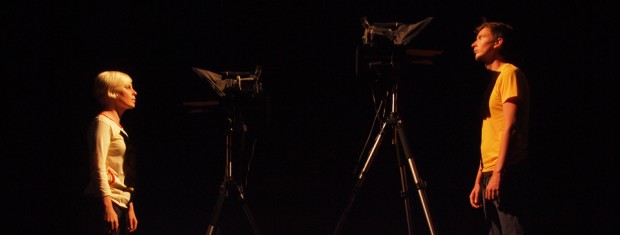You have no items in your cart. Want to get some nice things?
Go shopping
This weekend saw the first ever Night Watch festival at Cambridge Junction. Taking place over 24 hours, those of us who attended the “noon ’til noon” extravaganza saw dozens of pieces of theatre, dance, live art and installation which took us all around the venue and even the surrounding area. The show which kicked it all off was Action Hero’s Slap Talk, a five-hour durational performance which sees Gemma Paintin and James Stenhouse read a script of verbal sparring off an autocue into a camera for exactly 300 minutes. We were free to come and go as we wished, popping in briefly as we slurped our coffee or settling down for an hour or so. Then, later in the festival, at around three o’clock in the morning, Sarah Rodigari started Filibuster of Dreams, a four-hour piece focussed on dreaming and sleep. In the context of a 24-hour theatre festival, these two piece began to ask interesting questions about the nature of durational performance and its possibilities.
I think I can count on one hand the pieces of durational performance I’ve witnessed in some form or another; alongside Slap Talk and Filibuster of Dreams, I’ve seen Quizoola 24, Gatz and Hotel Medea. In fact, some may argue that those final two aren’t even durational in the conventional sense due to their focus on narrative and more traditional forms of meaning-making. This, then, begs the question: what do we mean by durational performance? Does it have to be performed non-stop, in an unchanging format which includes and builds on an inherent repeated idea or form? Or is it just a performance which takes place over a long period of time? If so, I could count the two times I’ve seen the three parts of Henry VI on one day or even The Bloody Great Border Ballad Project, which must have totted up about 30 hours over the course of the Edinburgh Fringe last year.
My instinct would dictate that a durational performance is one where an audience and the performers go on a journey together over a sustained period of time. All the examples listed above would follow this description, even though a number of them allow an audience to pop in and out as desired to check on progress. Nowhere was this more the case than with Quizoola 24, the online live-stream of which allowed those of us on Twitter to form a community throughout the course of the day, keeping one another in the loop and sharing moments of ecstasy and laughter from the comfort of our own homes. It was a unique experience, and its ultimate success came from the fact that is was shared.
That said, the creation of a community is in no way necessary to durational performance; Marina Abramovic, for example – the arguable Queen of Durational Performance – has created work which lasts three months and performs to individuals rather than audiences, so the durational element becomes more real for performer than for audience. A viewer may be aware of this feat of endurance, but they are unlikely to experience it as in real a way as the artist herself, meaning the ‘durational’ element draws out ideas of time and presence above all else. In this case, my attempt at description above falls apart.
About a year ago, Abramovic suggested that “long durational performance has the largest capacity to transform both performer and audience”. Though this runs the risk of coming across as self-indulgent on the part of the artist, it cannot be denied that one thing which fascinates us so much about durational performance is the work which is done by the performers. You only need to look to the focus on the fact that Scott Shepherd memorized the whole of The Great Gatsby for Gatz to recognize that we are endlessly excited by what artists have to go through when creating work like this. Then, as we are watching, we begin to realise that we are just as much a part of the artwork as those who have created it, as we become increasingly aware of the crucial role we play in its existence.
What durational performance always does, then, is remind us what it is to live. Alongside the laughter and the tears, the bizarre repetition and the beads of sweat trickling down the performers’ foreheads, durational performance is about breathing. In its strange way, the human brain suddenly turns on itself when watching something for any long period of time. Just think of the places your mind goes when you’ve been watching a box set of The West Wing non-stop for six hours. You start to become more present even as you’re drifting away from known reality. You clock your breathing, feel your heart beating. It is this experience which is at the centre of any durational performance and, like Night Watch itself this weekend, is one of the best ways of reminding yourself that you are alive.

About Dan Hutton
Dan is a freelance critic and theatre-maker. He won the Howard Hobson Award for Theatre Criticism at NSDF in 2010, 2011 and 2013, and in 2013 was the runner-up for the Edinburgh Fringe Allen Wright Award for Arts Journalism. Dan is also a director and co-runs Barrel Organ Theatre.





3 comments